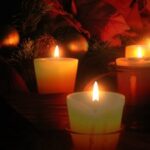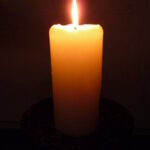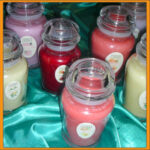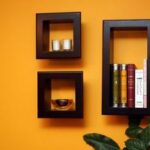Glass fairy lights, or fairy lamps, as they are sometimes called, date back to the beginning of the nineteenth century as a type of night-light that was kept burning all night using a small candle specially made for this purpose. The candles used did not burn quickly and could last up to twelve hours inside a glass fairy light. Each fairy light consisted of a metal base and a glass bottom and top to enhance the flame inside to make it glow. Fairy lamps came in clear or colored glass and by the end of the nineteenth century, companies like Mount Washington made fairy lamps using Burmese glass.(1) Almost every household had at least one fairy lamp so they would be able to see at night if one woke up in the dark.
One of the first fairy light manufacturers was Samuel Clarke, who first called the small lights this particular name. His trademark for these small glass lights was of a fairy holding a wand and it is presumed that is where the name came from. Clarke mass produced these small lights based on his profession as a candlemaker. He patented the design, and throughout the nineteenth century, other glass manufacturers started to make small night lights much like the first ones he made for the family household. Luckily, the majority of Clarke’s fairy lights were signed, making it easy to tell who made these. Fairy lights reached the height of their popularity during the late nineteenth century and in the early twentieth century. With the advent of electricity, fairy lights ceased production but they continued to be made by companies like Fenton for collectible use.(2)
Glass manufacturers made beautiful fairy lights, ranging from plain ones to exquisite decorated ones. Since fairy lights could be made from any type of glass, this gave the manufacturers a wide range to work with. Fairy lamps came in every size and shape imaginable, bearing etched designs or a satin finish, like the one seen here on the far left. With the proper type of candle, these lamps can be used today for use during either the day or night. Some collectors look for only one type of fairy lamp, such as those made of Burmese glass, or something more modern, such as those by Fenton. If you decide to start collecting fairy lights, make sure all the pieces are included in the lamp when you scour flea markets and antique shops for these beautiful little glass lights. Each lamp should have a candle cup, the metal and glass base, the glass cover, and a small chimney, usually made of clear glass, to allow the smoke from the candle’s flame to escape. Avoid buying fairy lights that have chips or cracks in the glass. Fairy lights were usually produced by the dozen for household use so it can be fairly easy to find these when you go shopping for them.
1. http://www.antiques-bible.com/ppf/term/Burmese+Glass/definition.asp
2. http://www.myantiquemall.com/AQstories/fairylamps/FairyLamps.html





